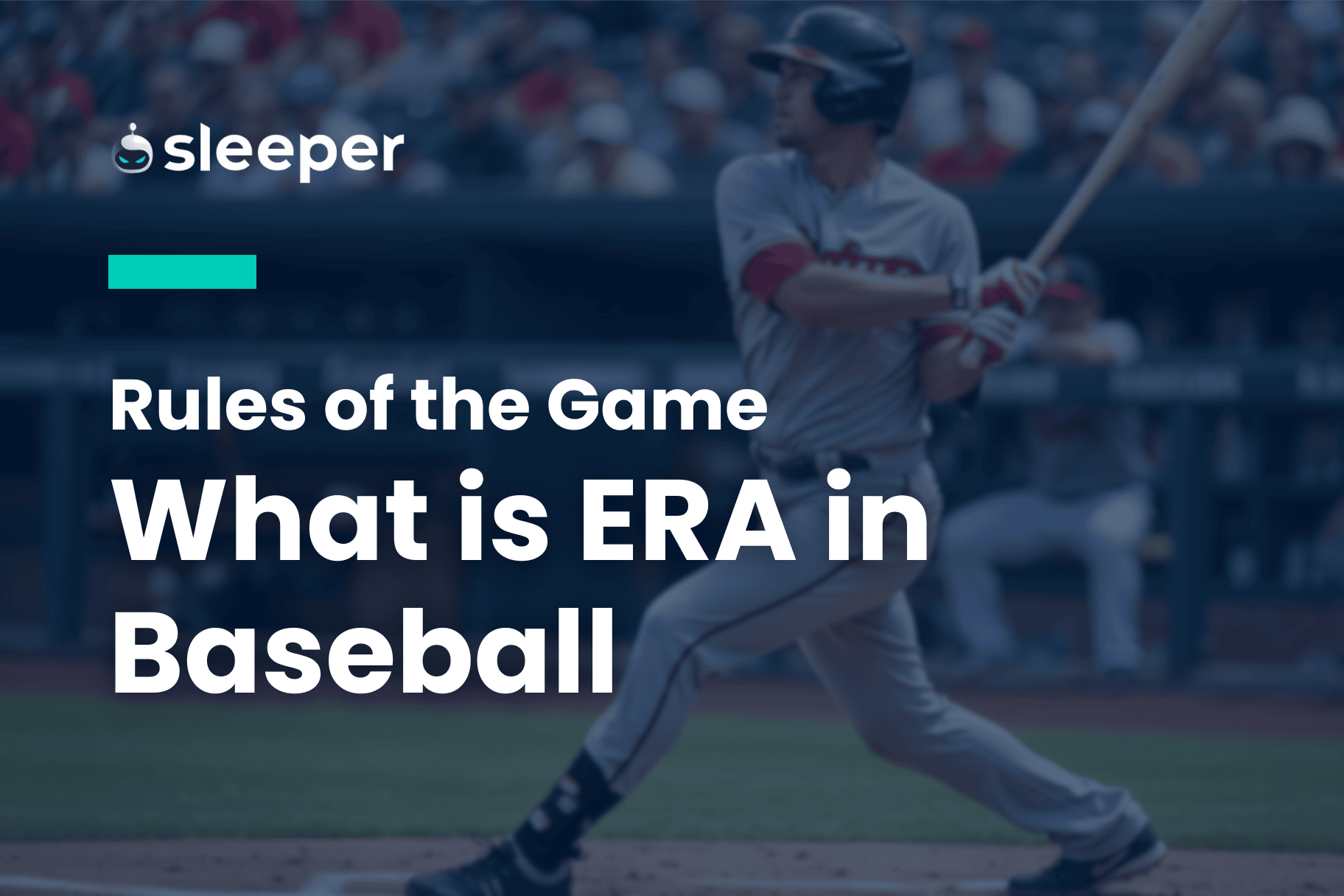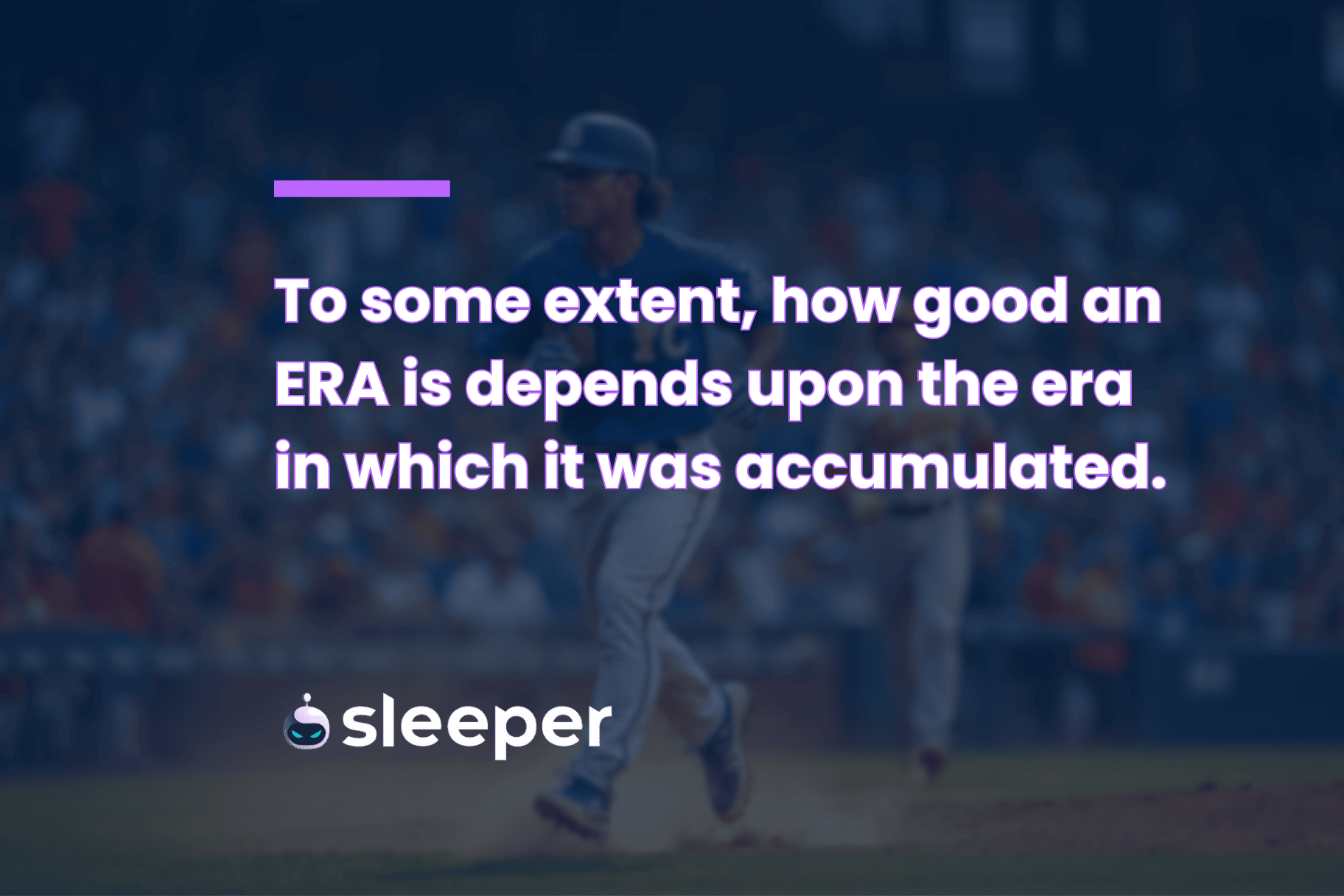ERA tells us how good (or bad) a pitcher is at preventing runs from crossing the plate, and we can tell you more about how to calculate it and some of the best (and worst) to ever do it.

For well over a century in Major League Baseball, Earned Run Average (ERA) has been one of the primary statistics — if not the singular main stat — used to gauge whether a pitcher is having a good game, season or career.
After wins and losses (or saves), ERA is the first thing the play-by-play announcer tells you about a pitcher when entering the game. And it’s arguably the most important data point in a pitcher’s profile when it comes time to vote on things like All-Star Games and Cy Young Awards.
What is ERA, though? How is it calculated, and what does it actually tell us?
By the end of this guide, you’ll know more than enough to enhance your baseball viewing (and fantasy baseball-playing) experience.
What Is ERA in Baseball?
ERA stands for Earned Run Average, which is how many earned runs a pitcher allows on a ‘per nine innings pitched’ basis. (Much like a golf score, the lower the ERA, the better the pitcher.)
Of course, this raises another question: What is an earned run?
Most runs — usually somewhere between 91 and 93% of them at an MLB-wide level in a given season — are of the earned variety. However, a run is considered unearned if it scored because of an error or a passed ball.
The run doesn’t need to score on the play in which the error was committed, though. For instance, if a batter leads off an inning by reaching first base because of an error and later comes around to score, that run is counted as unearned.
Moreover, any run that scores after the third out of the inning should have been recorded is also considered unearned. Building on the example above, maybe after the first batter reaches via error, the next two hitters strike out and then the fourth hitter — who would not have batted in that inning if not for the initial error — hits a two-run home run. Both of those runs would be unearned, as would any subsequent runs that score in that inning.
But wait. There’s more.
Since 2020, Major League Baseball has had the somewhat controversial extra innings rule where each team starts each inning from the 10th inning onward with a runner on second base. Any time that “ghost” runner scores, it is considered an unearned run.
One last note: With the exception of those automatic-runner-in-extra-innings situations, all runs are charged against the pitcher who allowed the runner to reach base, not necessarily the pitcher who allows them to score. This often comes up as a result of mid-inning pitching changes.
You don’t need to know any of that in order to calculate or understand ERA, though. It’s up to the official scorer of each game to make rulings on errors and determine which runs are earned and unearned.
And once we have the official tally of a pitcher’s earned runs allowed, calculating ERA is a snap.
ERA = 9 * (earned runs / innings pitched)
ERA can be calculated over any interval you choose.
Allowed two earned runs in seven innings pitched? That’s a 2.57 ERA (nine times two divided by seven) for that start.
Gave up 95 earned runs while logging 200 innings pitched for the year? That comes out to a 4.28 ERA.
Or if you’re Nolan Ryan and you allowed 1,911 earned runs in 5,386 career innings pitched, that’s a 3.19 ERA.
A word of caution when calculating ERA on your own: If you see a .1 or a .2 for innings pitched, those must be converted to .3333 and .6667, respectively. It won’t make any noticeable difference when calculating career ERA, but it can definitely mess you up for a single game. Three earned runs allowed in 5.2 IP would be a 4.76 ERA [9*(3 / 5.6667)], not a 5.19 ERA [9*(3 / 5.2)].
- See also: Baseball Statistics Explained
What Is a Good and Bad ERA in Baseball?
To some extent, how good an ERA is depends upon the era in which it was accumulated.
For the 1908 season, the league-wide average ERA in Major League Baseball was 2.37.
By 1938, it was up to 4.30.
Fast forward another 30 years to 1968 — AKA “The Year of the Pitcher” — and average ERA had shrunk back to 2.98.
By 2000, it had ballooned to 4.77.
Over the more than 150 years of Major League Baseball, though, the average ERA is 3.89.
It’s been more like 4.10 dating back to 2010, but let’s split the difference and say that 4.00 is a fairly average ERA.

For a starting pitcher who logs enough innings to qualify for an ERA title (minimum of 1 IP per team game played, usually 162), anything below 3.00 for a full season is considered good, while anything north of 5.00 might get you sent to the minors.
Whether an ERA is good or bad also depends on whether we’re talking about starting pitchers or relief pitchers, as maintaining dominance for 100 pitches is harder than simply pumping gas for one inning.
As such, for the high-leverage relievers around the majors, the standards for ERA excellence are much higher.
While league-wide ERA since 2010 has hovered at 4.10, only one of the 57 cases of a closer recording at least 40 saves in a season came with an ERA of 3.85 or worse attached to it. (Wade Davis saved 43 games with a 4.13 ERA for the Colorado Rockies in 2018.)
Nearly half of those 57 pitchers (24) had a sub-2.00 ERA, including 2012 Fernando Rodney, 2016 Zack Britton and 2024 Emmanuel Clase all ending up below 1.00.
During that same 15-year window, there have been just 10 cases of a qualified starting pitcher posting an ERA below 2.00 — three of which came in 2020, with about one-third as many innings pitched as a normal season.
The 10 Best ERAs in Baseball History
We’re going to throw a couple of different top 10 ERA leaderboards your way.
10 Best Career ERAs
First, for the all-time, ancient history fans, here are the 10 best career ERAs among pitchers who logged at least 1,000 innings pitched.
- Ed Walsh, 1.82
- Addie Joss, 1.89
- Jack Pfiester, 2.02
- Joe Wood, 2.03
- Jim Devlin, 2.05
- Mordecai Brown, 2.06
- John Ward, 2.10
- Christy Mathewson, 2.13
- Al Spalding, 2.14
- Rube Waddell, 2.16
Every single one of those pitchers had retired by 1923, though. Probably not too many Devlin devotees or Mathewson maniacs reading this thing.
So, how about a ‘Since 1969’ leaderboard?
That’s when the mound was lowered to its present height of 10 inches. 1969 was also the first year with division play and an expanded postseason format of four teams instead of just two.
1901 is generally considered the beginning of the ‘modern era’ of Major League Baseball, but 1969 is when baseball really started to become what it is today.
10 Best Career ERAs by a Starting Pitcher (Since 1969)
Best ERA, min. 1,000 IP, since 1969, primarily a starting pitcher.
- Clayton Kershaw, 2.50
- Jacob deGrom, 2.52
- Jim Palmer, 2.80
- Andy Messersmith, 2.89
- Tom Seaver, 2.91
- Pedro Martinez, 2.93
- Bob Gibson, 3.01
- Chris Sale, 3.04
- Mel Stottlemyre, 3.05
- Dun Gullett, 3.11
10 Best Career ERAs by a Relief Pitcher (Since 1969)
Best ERA, min. 1,000 IP, since 1969, primarily a relief pitcher.
- Mariano Rivera, 2.21
- Dan Quisenberry, 2.77
- Bruce Sutter, 2.83
- Kent Tekluve, 2.85
- Trevor Hoffman, 2.87
- John Franco, 2.89
- Rollie Fingers, 2.89
- John Hiller, 2.90
- Sparky Lyle, 2.91
- Gary Lavelle, 2.93
12 Best Single-Season ERAs (Since 1969)
Lastly, in that same ‘since 1969’ timeframe, here are the best single-season ERAs by a qualified pitcher. We’ll go top 12 on this one, since two in the top 10 hit their remarkably low marks during the drastically truncated 2020 campaign:
- Dwight Gooden, 1.53 in 1985
- Greg Maddux, 1.56 in 1994
- Shane Bieber, 1.63 in 2020
- Greg Maddux, 1.63 in 1995
- Zack Greinke, 1.66 in 2015
- Nolan Ryan, 2.69 in 1981
- Jacob deGrom, 1.70 in 2018
- Trevor Bauer, 1.73 in 2020
- Pedro Martinez, 1.74 in 2000
- Ron Guidry, 1.74 in 1978
- Justin Verlander, 1.75 in 2022
- Tom Seaver, 1.76 in 1971
The pitcher's mound was lowered in 1969 because Bob Gibson tossed 304.2 innings with a preposterous 1.12 ERA in 1968, becoming the only player in the past century with a sub-1.20 ERA in a season of at least 100 innings.
How to Use ERA in Fantasy Baseball?
In standard season-long fantasy baseball leagues, keeping your team’s ERA as low as possible is one of the biggest goals. Not only does it mean you fare well in that category, but a lower ERA should result in more wins / quality starts, more saves and usually a lower WHIP, too.
Read more: What Is WHIP in Baseball?
Even if grinding Daily Fantasy Sports (DFS) leagues is more your speed, ERA is still a crucial component, as your pitchers get penalized for each earned run allowed and are less likely to get points for a win or quality start if their ERA stinks.
It’s important to note, however, that ERA is not a predictive stat.
Sometimes, the momentum or inertia of an ERA can be nice. An object in motion tends to remain in motion, and a pitcher with a low ERA will often continue to pitch well, even if his peripheral stats suggest he’s mighty lucky to have that ERA.
That is not even close to always the case, though.
Stats like batting average on balls in play (BABIP), left on-base percentage (LOB%) and expected fielding independent pitching (xFIP) do a wonderful job of letting you know whether a pitcher’s ERA is likely to improve or worsen as the things that are largely out of their control regress to the league-wide average.
All the same, if you end up with both the AL and NL ERA leader on your fantasy team’s pitching staff, there’s a good chance you dominated most of the pitching stats throughout the season. So, while ERA isn’t itself predictive, collecting the best ERAs is the name of the game.

Frequently Asked Questions
Who has the worst ERA in MLB history?
We previously gave you some leaderboards for the best ERAs of all-time, but there’s a flip side to that coin, isn’t there?
Among pitchers with at least 1,000 innings pitched, the worst career ERA belongs to Jimmy Haynes, with a mark of 5.37 from 1995-2004 with the Orioles, A’s, Brewers and Reds.
In a single season with at least 150 innings pitched, Les Sweetland takes the cake with a 7.71 ERA for the 1930 Philadelphia Phillies — narrowly edging out teammate Claude Willoughby’s mark of 7.59 in the same season. Needless to say, the Phillies didn’t win very many games that year.
Do walks count in ERA?
If that walked batter comes around to score without an error being the reason that it does so, then yes, it would count against the pitcher’s ERA.
All that matters for ERA purposes is whether the run is earned or unearned. Whether the batter reaches base because of a hit, walk, a fielder’s choice or getting hit by a pitch, it could eventually hurt the pitcher’s ERA.
How does the ballpark affect a pitcher’s ERA?
Without question, the stadium can have an impact. There are venues like Colorado’s Coors Field or Cincinnati’s Great American Ball Park where it’s just harder to keep the ball in the yard, and others like San Diego’s Petco Park and San Francisco’s Oracle Park that tend to produce lower-scoring affairs.
ERA+ on Baseball Reference and ERA- on FanGraphs adjust for park factors in an effort to give a truer sense of how well (or poorly) a pitcher has fared, but it still doesn’t tell the whole story, does it?
Some pitchers benefit from upper echelon defense behind them, while others are routinely left in a state of frustration due to teammates’ poor range. Sometimes a bloop single by a No. 9 hitter can start an ERA-devastating rally, and sometimes a cleanup hitter tattoos a liner with a 116 MPH exit velocity directly into a glove.
There are a lot of factors and dumb luck components that ERA doesn’t fully convey, with ballpark being one of them. It’s still the most commonly used pitching statistic in baseball, though.
End of an ERA
Now that you know a good bit more about one of the primary statistics in pitching/baseball, you might want to start applying that new-found knowledge in the world of fantasy baseball.
If so, give Sleeper a try. The app is top notch, and its fantasy offerings are plentiful, from breaking news, to Sleeper Picks to season-long leagues.




